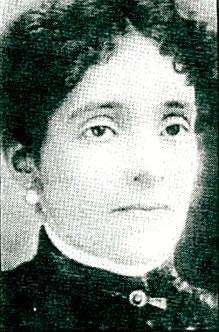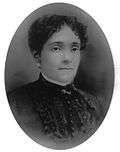Eliza Bryant
| Eliza Bryant | |
|---|---|
|
Eliza Bryant | |
| Born |
1827 North Carolina |
| Died |
May 13, 1907 Cleveland, Ohio |
| Occupation | Humanitarian |
Eliza Simmons Bryant (1827 – May 13, 1907) was an American humanitarian. She was the daughter of a freed slave and helped former slaves as a benefactor after the American Civil War.
Early days
Eliza Bryant was born in North Carolina to Polly Simmons, a slave, and her master. She was raised on a plantation in Wayne County. In 1848, Polly Simmons was freed, and moved with her family to Cleveland, Ohio, where she purchased a home, with funds from her master.[1] The Bryant family engaged in humanitarian work and provided shelter, food and water to black families. This occurred both prior to the Civil War as well as after the Civil War.
Humanitarian work

When she grew up, Eliza Bryant became a pioneer in the movement to assist African Americans in the Cleveland area, especially those who had moved from the southern states during the Great Migration after Emancipation Proclamation.[2] She became particularly concerned for elderly African-Americans, who were tremendously suffering from the poor living conditions in Cleveland. The majority of these were freed slaves, with nothing given to them except their freedom. Because of racial segregation, the homeless shelters did not admit them, and as a result, it left these elderly black families with nowhere to turn.
In 1893, Eliza Bryant began the work of establishing a home for the aged blacks, with help from Sarah Green and Lethia Flemming. She sought help for her cause through churches, community groups, business community, friends and family. She recruited volunteers who went door to door to raise money, food and clothing. Because of her dedication, John D. Rockefeller made a financial contribution, which helped to enable the purchase of the first home. In January 1895 a board of trustees was named for the proposed home. By 1896, enough funds were raised and a house was purchased for $2,000 with barely any necessities. The Cleveland Home for Aged Colored People was incorporated on September 1, 1896, and opened on August 11, 1897.[1]
Eliza Bryant died in 1907, and is buried at Woodland Cemetery in Cleveland.[1] Over the years, the Cleveland Home received more funding and was able to supply the necessities to these people. In 1960, its name was changed to Eliza Bryant Home for the Aged, in honor of its founder. Later, in 1999, the name was changed to Eliza Bryant Village (EBV).[3]
The mission of providing quality services, outreach programs in a dignified, compassionate and secure environment for seniors is carried out on 17 acres in Cleveland's historic Hough neighborhood at Eliza Bryant Village.
The skilled nursing 175-bed wing provides comprehensive nursing care in a home-like setting for older adults requiring 24-hour professional supervision. The comprehensive rehabilitation program helps older adults achieve their highest level of functioning to return home. The specialized care units are designed to assess and treat older adults in need of short-term recuperation from a hospital stay to long-term medical care. To meet a need for memory-impaired residents, Eliza Bryant Village opened the first Alzheimer's unit in Cleveland in 2003.
Eliza Bryant's Adult Day Program, one of the oldest in Cuyahoga County, is designed to provide a daily routine to enhance each older adult's well-being and provide respite to their families. Activities include art therapy, gardening, dancing, cooking and fitness programs.
Eliza Bryant Village features three modern, comfortable housing facilities to provide older adults with all the comforts of home in a community-like setting. The senior housing is made up of the Garden Estates, 44 one-story cluster units; Eliza Bryant Manor, a 60-unit low-rise apartment building and Amasa Ford Lodge, 45 units of housing.
References
- 1 2 3 "Women in History: Eliza Bryant biography". Lakewood Public Library. Retrieved 2007-05-02.
- ↑ "Eliza Bryant pioneered Black nursing homes". The African American Registry. Archived from the original on 2007-01-27. Retrieved 2007-05-02.
- ↑ "History of Eliza Bryant Village". Eliza Bryant Village. Retrieved 2007-05-02.
- ↑ Eliza Bryant Village
